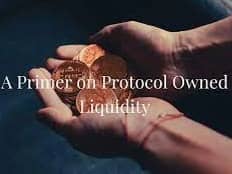POL (Protocol Owned Liquidity)
Protocol owned liquidity (POL) is a new approach pioneered by Olympus DAO to provide liquidity to tokens on decentralized exchanges.
Protocol owned liquidity is an innovative solution to the mercenary capital problem, whereby protocols engage in a so-called “race to the bottom” to provide higher and higher incentives to attract liquidity providers, in-turn diluting the value of the protocols through the high issuance of tokens. [1][4][5]
Overview
Protocol owned liquidity (POL) is one of a few key innovations of the DeFi 2.0 narrative. Protocol-owned liquidity seeks to solve the mercenary capital problem of DeFi 1.0.[3]
Decentralized finance, known as DeFi, has seen explosive growth since 2020, bringing with it the potential to disrupt traditional finance.
In particular, the rise of decentralized exchanges (DEXs) — most notably Uniswap — introduced key innovations that allowed trading to be facilitated without a centralized intermediary, utilizing an Automated Market Maker (AMM), liquidity pools and liquidity providers.
However, these innovations are not without their drawbacks. Namely, the mercenary liquidity problem plagues protocols, who often need to incentivize liquidity providers with substantial rewards to provide liquidity to enable trading of their token.
The mercenary capital problem that plagues DeFi 1.0 protocols, especially automated market makers (AMMs), is caused by protocols seeking to incentivize users through LP tokens and trading fees. Incentivizing users to add value to a protocol sounds like a meaningful addition to an ecosystem. But users can easily switch to the protocol offering the best incentives, creating a race to the bottom scenario for protocols as they increase the supply of their governance token and, in doing so, decrease its value. [3]
In this backdrop, a new form of providing liquidity to tokens on DEXs emerged in the form of protocol owned liquidity. This model developed by Olympus DAO, promises not only to resolve the mercenary liquidity problem, but also to create a reserve currency in the process.
Instead of relying on providing incentives to the market to provide liquidity to liquidity pools, the protocol owned liquidity model instead utilizes a “bonding” mechanism.
In the future of DeFi, protocol-owned liquidity (POL) is a very important concept. POL is a popular provisioning tactic amongst some major revenue-generating initiatives in the market. It is indeed an interesting formula to diversify a protocol treasury and, if architected correctly, a sustainable market for the native asset. Low liquidity induces volatility.
Arguably, Ethereum (ETH) is the prevalent pair for all decentralized markets on its network. While this asset has its benefits, it also inherits price exposure, which either is a magnitude greater or less than that of any token.
Protocol-owned liquidity (POL) is one of a few key innovations of the DeFi 2.0 narrative. The protocol behind this invention is Olympus DAO. Protocol-owned liquidity seeks to solve the mercenary capital problem of DeFi 1.0.[6][7][8]
Bonding process
The bonding process involves the protocol itself selling their own token (e.g. OHM) in exchange for another token (e.g., ETH or DAI) or a liquidity pool token (e.g. OHM/ETH) from a buyer. The buyer is incentivized to bond (instead of buying tokens on-market) by the protocol selling their token at a discount (usually 5–10%) to the current market price, which is vested over a period (typically under a week) to prevent an immediate arbitrage opportunity.
The net result of the bonding process is that the protocols end up holding a large number of valuable tokens in their treasury. This process can be thought of analogously to how a reserve bank (i.e., the protocol) would sell their country’s currency (which they control) to buy a foreign currency from the market, and thus store this foreign currency in their treasury.
Bonding essentially involves the protocol selling their tokens at a discount to buyers, who in exchange will provide another token, which forms part of the protocol’s treasury. The treasury can then be deployed to provide liquidity directly to DEXs (earning trading fees) and can be invested to generate returns.
With the tokens received from the bonding process, the protocol utilizes these tokens providing liquidity to liquidity pools on DEXs for their own token in the process collecting the transaction fees, or investing the tokens to earn a return.
Protocol owned liquidity is likely to be an ongoing feature of the DeFi landscape, with protocols utilizing a mix of the protocol owned liquidity model and traditional liquidity pools for trading on DEXs.
Protocol-owned liquidity is a natural evolution that will strengthen protocols and DAOs staying as a mechanic to strengthen liquidity and reward the community.[2]
Liquidity-as-a-service (LaaS)
This concept enables protocols to easily utilize the protocol owned liquidity model. The protocol platform serves as a bond marketplace, whereby users can purchase a bond from protocols listed paying a transaction fee. Marketplaces such as these should reduce friction in issuing bonds, providing a valuable matching service between protocols and capital providers that should continue to drive the adoption of this model in DeFi.
Pros and cons of Protocol Owned Liquidity (POL) Model
Pros
- In part addresses the mercenary capital problem, with protocols in theory paying a lower cost (in the form of a discounted tokens) to retain liquidity
- Protocol keeps the trading fees from their own trading pair in DEXs
- Treasury assets can generate revenue for the protocol
- Assuming sufficient scale in the treasury, the trading pair should be able to absorb higher trades with less price impact
Cons
- Reliant on incentivizing users to bond through a discount to the market price. More competition in this space may result in higher discounts being offered, which would dilute existing holders further
- Systemic risk of protocols using this model to create a reserve currency, with the chance of sustained selling eroding the “price floor” and creating a negative feedback loo
